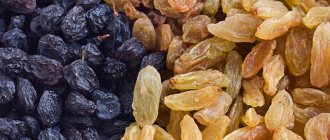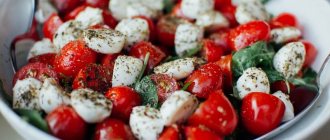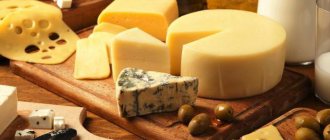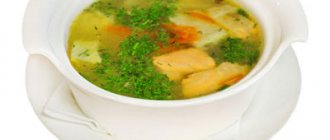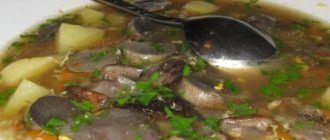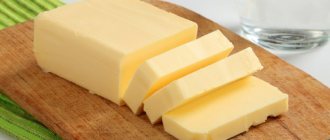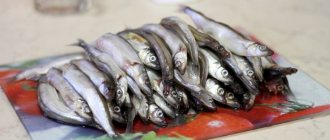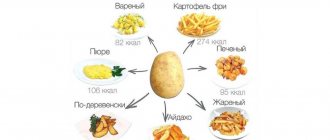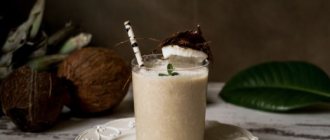Fruits and berries » Grapes
0
1151
Article rating
Kira Stoletova
Grapes are a perennial shrub that produces tasty fruits. The plant is characterized by the presence of clusters and branching. The fruits are eaten raw and also processed into wine and other products. Kishmish grapes are a type of shrub characterized by the absence of seeds and large berries.
The benefits and harms of Kishmish grapes
Description of popular varieties
Kishmish grapes have a number of popular varieties:
- Golden (Radiant). The ripening period of the variety is 120-140 days. It has a bright, pleasant taste and is suitable for use in winemaking. The clusters are large, cone-shaped, 35-45 cm long. The weight of one bunch reaches 1 kg. The fruit looks like this: it has the shape of an ellipse, light red or pink color.
- Zaporozhye. An early ripening variety that is characterized by good tolerance to temperature changes. Ripe fruits appear in early August. The weight of the bunches reaches 800 g, but there are also cases of giant formations whose weight exceeds 2 kg.
- Far Eastern. Frost-resistant variety. According to the description, it has small clusters weighing 400-600 g. It is preferable to eat it fresh.
- Ramminga. A variety similar to the Far Eastern one, which is characterized by the small size of the berries and their dark color.
- Novikova. It has small bunches weighing up to 300 g. It is used for processing into wine and juices. It tolerates transportation well due to its elastic berries and elastic peel.
Calorie content of different grape varieties. What is the calorie content of berries by variety?
Below we consider the calorie content of the most common grape varieties.
Green grapes
There is an opinion that green varieties contain much less calories than black or red grapes. That is why during diets it is preferable to eat green bunches. But this information cannot be considered unambiguous.
The calorie content of berries largely depends not on the color, but on the variety.
As with all other products, this indicator is measured per 100 grams of weight. In farming circles, green berries are called white, and they are divided into two types of varieties: table and industrial.
- Chardonnay, Rkatsiteli – 60.3 kcal;
- Aligote, Pinot Blanc – 63 kcal;
- Muscat – 66 kcal.
- Table varieties - these varieties are intended for fresh consumption and do not undergo any processing. Table varieties are sweeter than technical varieties, and accordingly contain more sugar. This results in their high calorie content. For example, the Lady Fingers variety has an energy value of 70 kcal.
- Technical – used for processing to produce various products, such as juice or wine. These litters have a lower calorie content, which varies from 41 to 66 kcal. These include:
Riesling – 43 kcal;
Black and red grapes
Many experts claim that such varieties are distinguished by the largest amount of vitamins and the content of beneficial amino acids. It is these berries that are useful to consume for the prevention of cardiovascular and cancer diseases. Black grapes also help very well with respiratory diseases.
As for the calorie content of such berries, it is higher than that of technical varieties of green grapes. But at the same time, it is on the same level as table varieties.
- Cabernet Sauvignon, Merlot – 64 kcal;
- Cardinal – 66 kcal;
- Isabella – 71 kcal;
- Lydia – 75 kcal.
Composition and calorie content
Depending on the variety of raisin grapes, its calorie content ranges from 60 to 100 kcal per 100 g of product. If we translate this into more conventional measures, then a spoonful of berries will contain 3.7 kcal, and a standard glass will contain about 19 kcal. Berries contain 90% water.
Nutritional value of raisin grapes per 100 g:
- fats - 0-06 g;
- proteins - 2.4 g;
- carbohydrates - 66 g;
- nutritional fiber - 10 g;
- sodium - 115 g.
Based on the data, it is clear that Kishmish grapes have high nutritional value. This is taken into account when creating menus and diets.
Ripe berries contain acid:
- apple;
- lemon;
- amber.
Kishmish grapes have a number of antioxidants:
- flavonoid;
- quercetin;
- essential oils;
- chlorophyll;
- polyphenol.
Calorie content of raisin grapes
Sweet seedless berries are quite high in calories, so people who are overweight adjust their intake of grapes.
Glycemic index
The glycemic index of sultanas is different for all varieties. White grapes have a value of 44-58. Black berries have an index of 44-52. This indicator is considered average, so eating grapes does not have too much effect on changes in blood glucose levels.
Carbohydrates contained in berries are broken down at an average speed. However, the fruits do not provide a feeling of quick satiety, so they are consumed either as a dessert or as one of the ingredients in a salad or other dish.
BJU
The ratio of proteins, fats and carbohydrates is approximately the same in both light and black grapes - 4%: 2%: 100%.
Despite the fact that berries are rich in fructose, glucose and sucrose, you should not exclude them from your diet, as they contain complex compounds with pectin, fiber, starch and glycogen. Therefore, after eating the fruits, there is no too rapid release of sugar into the blood, which means that the body does not store subcutaneous fat for future use.
Composition and properties
Berries, rich in antioxidants, have a unique composition (per 100 g of product):
- dietary fiber - 1.6 g;
- water - 80.5 g;
- mono- and disaccharides - 15.4 g;
- organic acids - 0.8 g;
- polyunsaturated fatty acids - 0.2 g;
- saturated fatty acids - 0.2 g.
Kishmish contains vitamins A, C, E, H, PP, group B. Of the beneficial microelements, grapes are rich in potassium, boron, aluminum, rubidium, copper, calcium, and sodium.
Since light sultanas contain chlorophyll and black sultanas contain resveratrol, both varieties are healthy. Light berries are recommended for children, as they actively participate in metabolism. Black fruits are included in the diet of adults because they improve heart function.
Important! Berries grown on an industrial scale are treated with chemicals to prevent plant diseases. This product is soaked in cold water for 1-2 hours and then washed under running water.
Vitamin and mineral composition
Grapes have a positive effect on humans
100 grams of grapes contain the following vitamins:
- A (RE) - 5.5 mcg;
- PP (niacin equivalent) - 0.7 mg;
- E (TE) - 0.6 μg;
- B1 (thiamine) - 0.16 mg;
- B2 (riboflavin) - 0.1 mg.
Mineral composition:
- calcium - 78 mg;
- magnesium - 40 mg;
- iron and trace elements - 2.8 mg;
- phosphorus - 130 mg;
- potassium - 800 mg.
Calorie content and nutritional value of black grapes per 100 grams: with seed, without seed, black sultana
| Energy value | Squirrels | Fats | Carbohydrates | Fibers | Sugar | |
| Black with bone | 65 | 0,72 | 0,72 | 17,4 | 0,7 | 16,7 |
| Black pitted | 90 | 1 | 1 | 24 | 1 | 23 |
| Black sultana | 299 | 3.1 | 0.5 | 79 | 3.7 | 59.2 |
Use of berries
The beneficial properties of raisin grapes allow it to be used as an additional treatment. Also, its use generally has a positive effect on a person: it has a good BJU indicator. Its glycemic index is 56.
Benefits and healing properties for the body:
- improving the functioning of the nervous system;
- eliminating stress and sleep problems;
- normalization of liver and kidney function;
- restoration of pressure during hypotension;
- useful in the fight against excess weight;
- improvement of metabolism;
- improving the functioning of the gastrointestinal tract;
- preventing the formation of thrombosis;
- improvement of the condition of respiratory tract diseases.
Also, the benefit of raisin grapes is that it helps in removing toxins from the body. The berries have a rejuvenating effect and increase the level of hemoglobin in the blood. Eating sultanas improves overall mood and prevents depression.
Glycemic index
The glycemic index of grapes per 100 grams is 59, raisins – 64.
This means that the GI of this berry is average (56-69). Low values are 55 or less. High index – 70 and above. Such products should be avoided.
One serving of carbohydrates for diabetics should contain 15 grams of carbohydrates. A 1-cup serving of grapes contains 16 grams of carbohydrates, of which 1 gram is fiber and 15 grams are sugar. But since fiber is not digested and does not raise blood sugar levels, it is often subtracted from the carbohydrate content when calculating carbohydrates. Therefore, grapes are classified as low GI foods.
Impact of eating low GI foods:
- Enhances natural weight loss.
- Increases the body's sensitivity to insulin.
- Helps control cholesterol levels.
- Reduces the risk of heart disease.
Harm and contraindications
Eating sultanas is harmful if:
- disorders of the gallbladder;
- pancreatitis;
- stomach ulcer.
The fruits are also contraindicated for patients with diabetes. The reason for this is the large amount of sugars in the berries, which can harm the body. It is contraindicated for everyone to eat too many grapes at a time: this causes severe abdominal pain, diarrhea and flatulence.
You should not eat grapes if you have a stomach ulcer.
Kishmish is contraindicated for adults and children with dental diseases and other problems in the oral cavity. Berries contain large amounts of fruit acids, which destroy tooth enamel and harm gums.
Eating fruits during pregnancy is not prohibited, but excess sugar leads to early obesity in the child, which will cause problems during childbirth. They will benefit from 1 bunch per day.
To ensure that the antihydrins used to treat the bushes do not cause harm to human health, the bunches are thoroughly washed under running water. Dried berries are also coated with low-quality dyes during preparation, so when purchasing, pay attention to their appearance.
For what diseases are the berries used?
- Migraine. Grapes act as a brain protector that improves memory, concentration and brain health. Due to the presence of riboflavin, it is beneficial for people suffering from migraines. Vitamin B2, found in the berries and juice, interacts favorably with liver functions, which often play a role in the development of migraines.
- Prevents bone loss. A team of researchers from Denmark studied the effects of resveratrol on men with metabolic syndrome. Metabolic syndrome increases the risk of heart disease, stroke and diabetes and is associated with low-grade inflammation that can lead to bone loss.
- Cardiovascular diseases.
There are several reasons why eating grapes is good for your heart:
- Reduces blood pressure. One cup (151 grams) of berries contains 288 mg of potassium, which is 6% of the daily value. This mineral is essential for maintaining healthy blood pressure levels.
- Reduces cholesterol levels. Compounds found in grapes help protect against high cholesterol levels.
Kishmish in cooking
The calorie content of berries allows you to eat them in large quantities. Ripe raisin grapes are pleasant to eat raw. The reason for this is the elastic flesh and the absence of a seed. To wash off dirt from freshly picked bunches, it is better to soak them in a container of cool water for an hour.
The berries are also consumed dried or dried. To do this, they are subjected to temperature treatment, the description of which is similar to the method for preparing raisins, but does not take much time. The grapes are heated in the oven or cooked in a steam bath.
There is also a way to prepare pickled sultanas. These berries acquire a spicy flavor and become a little tart. For this purpose, take a large variety.
Grapes are used as a decoration for cakes, and they are also added to fruit salads and desserts. Juices and compotes are made from grapes, as well as jelly and homemade wine, which has a beautiful color.
Kishmish is also suitable for processing into jam or jam. For this, varieties with soft pulp and thin skin are used so that the product is without bitterness. Kishmish grapes increase the energy value of fermented milk products such as yogurt, cheese or cottage cheese.
Cooking raisins
One popular way to consume berries is as raisins. It has good nutritional value and minimal calories. Before preparing raisins from sultanas, prepare them:
- spoiled grapes are removed from the bunches;
- washed and dipped in boiling soda solution for 5 seconds;
- rinse in running water.
There are 2 ways to dry sultanas for raisins. For the first, light is used. The grapes are laid out in a thin layer on a wire rack and placed outside in the shade, where they dry for 3 weeks. They can also be dried under direct rays, but not longer than 15 days.
While drying, the grapes are mixed and turned over every 2-4 days. Ready raisins are determined by the shine on the surface of the berries, which become very elastic.
Raisins are also obtained through heat treatment. To do this, place the fruits on a wire rack and place it in the oven. The temperature should be minimal and the door should be open. Under such conditions, the grapes are dried for 2 hours and then taken outside, where they reach condition within 5 hours. The procedure is repeated for 5 days. Thermally produced raisins are darker and slightly caramelized.
A little about the history of grapes
In what century BC (of course) this perennial plant began to be grown has not been precisely established by scientists. But personally, it seems to me that this happened a very long time ago. Why? Yes, think for yourself. If in ancient times the Egyptians, Greeks and Romans held grand feasts where they drank wine in abundance, then what did they make it from? That's right, from grapes. And of course, since there was winemaking, there were grapes.
And it is precisely from those ancient times that the health benefits of grapevine fruits have been known. But I’ll tell you a secret, these berries not only contain useful substances, but also successfully reduce the impact of harmful ones on the human body. Moreover, as they say, the process of absorbing grapes slows down aging.
And of course, it is best to eat fresh berries. And in this regard, spending a few days on a grape diet during the fruit ripening season would be quite good for you and me. The rest of the time, it is useful to simply eat 200-300 grams of the mentioned fruits per day, and preferably separately from the main meal. Why? Doctors just say that this way vitamins and all sorts of nutrients are better absorbed. And I assure you, this, in addition to everything, will help strengthen the heart, kidneys, and other organs.
I am sure you will also be interested in my previous articles about the health benefits and harms of watermelon, strawberries, serviceberry and pomegranate.
Which type is better: black or green
It is impossible to answer exactly which type of sultana is better. Firstly, it is worth considering a person’s preferences and his state of health. If a person just wants to enjoy delicious wine berries, then it is better to turn his attention to black sultanas. The fact is that this particular grape variety contains more useful components, antioxidants and vitamins.
But for people who are prone to allergic reactions, it is better to give their preference to green grape varieties, as they are less allergenic. As for calorie content, there is no particular difference in dark and green varieties. Kishmish definitely does more good than harm. Therefore, it is best for a healthy person to include these berries in their daily diet.
If a person has any health problems for which the use of sultanas is prohibited, then it is better to give it up altogether.
What's the best way to eat grapes?
I heard that it is much healthier to eat berries with the skin, and besides, you must admit, it’s even more convenient. There is no need to clean anything, just give this yummy a good wash and then enjoy giving it its due.
In addition, they say (although I confess that I haven’t personally tried it myself) that eating it with seeds is even more beneficial. This helps cleanse the body. By the way, and losing weight too.
This is very tempting, but personally, I’ll tell you a secret, I’m not a fan of choking on seeds, which is why I prefer sultanas. And these fruits do not contain seeds. And if anyone doesn’t know, know that this is really so, because this grape variety was specially created by breeders so that people would not choke on the seeds.
